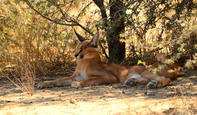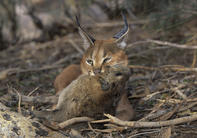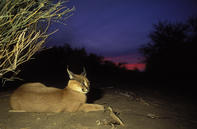The Caracal (Felis caracal caracal) derives its name from the Turkish word “karakula”, which means black ear. As the name implies, the back of this wild cat’s ears are black, topped with long black sharply pointed, lavish tufts.

A caracal has a short dense coat, ranging from light sandy to a deep reddish brown, depending on their geographic location. Caracals have subtle black and white markings on their faces and white bellies with red spots. Melanistic (totally black) individuals have also been spotted.
Male caracals are larger and heavier than female caracals, with adults measuring between 75 to 120 cm long and weighing between 9 kg to 18 kg. Their hindquarters are slightly higher than their shoulders, allowing them to jump up to three meters high.
They have short tails that measure between 15 cm to 35 cm long. The front paw print is slightly smaller than the back paw and does not include any nail markings. They are solitary animals, except in the mating season when males may be spotted with females or females with their young.
The gestation period is about 80 days long, with females producing an average of two kittens per litter. It takes up to 10 days for the kittens to completely open their eyes. They are weaned at ten weeks and remain with their mothers for up to a year. There are records of caracal that have lived up to 19 years in captivity, so they can grow quite old.
According to the Tenikwa website, the old saying “To put the cat among the pigeons” stems from an old Middle Eastern practice, where a caracal used to be placed in an arena with a flock of pigeons and people then betting on the number of pigeons the caracal would catch once released.
Killing and Feeding Pattern

Caracals are primarily night creatures, but may also operate during the day if not disturbed. Their home ranges can be anything from 400 ha to 10 000 ha depending on the availability of food, with the range of the males often overlapping that of two or more females. They prey on a variety of mammals, sometimes even ones that are larger than themselves.
Prey is stalked up to close range and then pounced on, caught at the underside of the throat and smothered. Victims may have bite marks with two puncture wounds on either side of the throat or windpipe and there may be claw marks, either on the shoulder, belly or hindquarters of the prey. More than one animal may be killed during a hunt, but only one will be fed on.
The skin will be chewed off at the point of entry, with no loose flap remaining as is the case with a jackal. Eating normally starts at the back and inside of the hind leg, but the brisket and shoulder may also be taken.
Wool and hair may be plucked out before eating. They do not break or chew large bones, nor eat the stomach of an animal. The prey may be partly covered with vegetation or soil and there have been reports of caracal storing their kills in trees, as do leopards.
Management

Caracal may develop a taste for livestock, especially sheep and goats, but this can be prevented with fencing or the kraaling of animals. The Predation Management Forum's manual, suggests that stones should be packed at the bottom of the fences to prevent animals from crawling under it.
The addition of electric wires will strengthen this measure. Noise, light and scent deterrents, shepherds, collars and guard animals, such as donkeys or Anatolian dogs, may also help. To address predation problems, traps can be set at a kill – particularly one that has not been disturbed – or on the routes used by the caracal.
Alternatively, the caracal can be hunted by night or with dogs, but the dogs should not be allowed to have any contact with the caracal.
By Glenneis Kriel